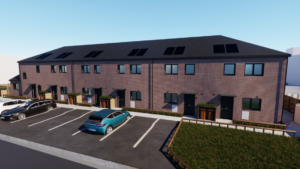Why we shouldn’t fear build-to-rent – it could change our cities for the better
 The built-to-rent sector has a negative reputation for many millennials and young people who want to get on the housing ladder, but the UK should embrace it if we are to meet the needs of a changing population, argues Alex Smith, head of construction at the law firm, Shakespeare Martineau.
The built-to-rent sector has a negative reputation for many millennials and young people who want to get on the housing ladder, but the UK should embrace it if we are to meet the needs of a changing population, argues Alex Smith, head of construction at the law firm, Shakespeare Martineau.
Alternative living accommodation is on the rise and is transforming the UK’s towns and cities. Fuelled by the changing needs of an ageing – and more transient – population, developers and local authorities are re-thinking the types of accommodation they provide.
This alternative to the traditional model of owner-occupier has its fans and critics, so what is this property revolution and how is it changing the way residential accommodation is thought of?
The newest player in the residential accommodation market is ’build to rent’. This model, where residents rent a property from a landlord has become commonplace in many locations around the world. However, in the UK, its adoption has only recently begun to pick up speed.
In many ways, the growth of build to rent is fuelled by generational attitudes to housing and home ownership. Where in the past owning a home was seen as a badge of financial success, younger generations – being more transient in nature – are now more inclined to stay in rented accommodation for longer periods of time.
Younger generations, particularly graduates, are currently one of the prime targets of the UK’s build to rent sector, which has gained pace in predominantly university cities. Graduates looking for accommodation to suit their new lifestyles, focus on experiences, rather than ‘things’. Often, previous experiences with new modern student housing leads to purpose-build rental accommodation offering something of better quality than traditional market alternatives.
Through nearly all types of city centre build to rent accommodation, design and function are placed at the forefront. New developments feature spacious communal living areas, in-built Wi-Fi and other facilities, such as a concierge, gyms, cinemas and private dining rooms. Compared with other more traditional parts of the rental market, these schemes command higher levels of rent, however this is of course compensated for by the range of additional facilities available.
Whilst graduates are a ready market for this new type of accommodation, this more transient approach to work and property extends throughout age demographics. There are many reasons, whether financial or lifestyle, why individuals and families may consider that a city centre rental property provides them with a more suitable alternative to property ownership, especially as many properties come with longer, more flexible tenure options.
For older generations too, the build to rent sector offers new types of accommodation which may be more suitable for later living. Couples or individuals who still live in family homes may be more inclined to ‘right size’ into rented accommodation if it fitted their needs in terms of quality, location and adaptability for the future. This has the joint benefit of freeing up housing stock for conventional buyers further down the chain, for example allowing families looking for larger properties outside of a city centre environment.
From an individual city or a local authority perspective, enthusiasm from construction companies to develop build to rent schemes is wholly positive. Ultimately, an increased variety of urban accommodation means that people of all ages are much more likely to stay and continue contributing to the local economy, invigorating the jobs market and providing a stream of talent into an area.
However, the types of schemes needed very much depend on the target city, as the personalised aspects of this type of development must match the needs and wants of the target demographic. For example, this could be the graduate market in university hubs or in cities where large employers are established or relocating.
In locations where the types of build to rent schemes do not match the wants of the target population, problems can arise, both with a lack of potential tenants and frictions between developers and local authorities. For example, whilst the conversion of city centre units into multi-unit schemes will work for some, if the city is severely lacking in good quality office space, local planning authorities may display hesitancy towards granting planning permission for development.
Ultimately, build to rent is about providing a new breed of residential accommodation that meets the needs of an increasingly transient, modern-day population. It is not something to be feared, rather, it should be embraced as an opportunity to change the faces of our cities for the better.















